Aviation of the Red Army in the Civil War. Some features of combat use
But Soviet aviation, having entered the battle initially without centralized leadership, without organized supply, without an orderly complex of fleets, warehouses and airfields, without a sufficient cadre of experienced and reliable pilots, nevertheless, grew and strengthened. The selection of aircraft was quite random - which made it difficult for pilot training. Owing to the blockade, Soviet Russia had to send airplanes to the front that did not meet the requirements of the time. The old “Newpors” and “Farmans” with worn out engines could not meet modern (at that time) requirements.
The air detachments had major organizational defects, there were no experienced bosses - which, of course, affected the combat capability of the aviation units.
Not better deal with the aircraft and the enemy. The organization of white aviation was also carried out in the course of the armed struggle and was also hasty and not always organized.
Entente powers used only a tiny part of their mighty aviation. Deliveries were made for the needs of the White armies. So, by the middle of 1919, the city of VYuR receives the British de Hivilends. In the Arkhangelsk operation, the Anglo-Americans used the hydroaviation - carrying out deep intelligence in the red rear. With the appearance of the White Guard army on the Northern front, the British formed Russian aviation squads in the French Sopwicz doubles, which the Reds did not have time to take out of the port of Bakarinas.
Accordingly, in the Civil War, the scale of aviation activity was, compared with the air war in the First World War, insignificant. The specifics of the armed confrontation also gave a special character to the actions of aviation. Such activities as shooting corrections, aerial photography, infantry aircraft service, lost their previous meaning. Intelligence has become extremely complicated due to the inconstancy of the fronts, the mixing of the territories of the adversaries, the chaos in the organization of army structures. The importance of bombing, assault strikes, campaigning activities, the organization of communication between groups of troops has grown.
The value of fighter aircraft has decreased.
With extreme instability of the fronts in the Civil War and limited resources, squadrons could move quickly along navigable rivers or rail lines - which allowed them to quickly move to the right direction.
But, of course, mainly the aviation service in the Civil War retained a general continuity with the activities of aviation in the world war. There was a struggle for air supremacy, support for ground forces, reconnaissance, a communication service, and fulfillment of special assignments.
Of particular importance was the struggle for supremacy in the air. A party with qualitative and quantitative superiority could have hampered the penetration of the enemy deep into the positions of its ground forces. An example is the actions of German and red aviation units in Lithuania and Latvia. In this region, red aviation, yielding to the opponent in strength and speed, could not penetrate the line of its front.
But the struggle for air supremacy in the Civil War was episodic, giving first place to other forms of aviation. The absence of serious air defense and the weakness (on some fronts) of enemy aircraft made the work of aircraft possible at low altitudes. It became less dangerous to lower in the rear of the enemy to a low altitude - which increased the effectiveness of assault attacks and bombing of columns, transports, batteries. Combination of intelligence with active percussion becomes the rule in the Civil War.
The impossibility of servicing a huge front with the help of a small number of aircraft led to the triumph of the principle of concentration of forces in the crucial point: the necessary transfer of aviation forces and equipment was carried out, and aviation was effective only where it was assembled into shock fists - at the cost of exposing less important sectors.
One of the first places in the arsenal of aviation actions in the Civil War was occupied by actions against ground targets. They consisted in shooting machine guns and bombing - both live and non-live targets. The objects were ferries, armored trains, railway junctions, buildings and structures, bridges, cavalry and infantry of the enemy.
So, when, during the battles at Manych in 1919, General Patirovsky’s cavalry corps and General Pokrovsky’s corps next to the right flank stopped within sight of Dumenko’s red cavalry threatening their right flank, the cavalry commander, General Wrangel, orders the corps - with the support aviation to attack Dumenko. 9 airplanes flew out to complete the task - but most of them were not suitable for bombing. White cavalry stretched into marching columns, moving north, while the red remained in place at the farm Korolkovo in reserve order. Despite the fact that some of the planes did not correspond to the task, the effect of the bombing was enormous. The Reds suffered heavy losses in people and horses - and scattered across the field in complete disarray. As a result, Dumenko was unable to put his main forces in order in a timely manner and, without putting them into battle, withdrew, giving the opportunity for General Pokrovsky’s cavalry corps to secure the right flank of General Shatilov’s troops.
When the 25 of May the fortified front of the Reds under Perekop was broken through by white pieces, the actions of aviation were also of key importance. Having broken the resistance of the red artillery, she transfers her strike to recalcitrant infantry. The stunning actions of huge bombs, the shelling of machine guns from a height of 40 - 100 meters completely demoralized the infantry, which, throwing in panic weapon, fled. The White Command, in its order, declared that the success of the operation to seize Northern Tavria was caused solely by the actions of aviation.
The activity of the red aviation in the Borisov region in May of 1920 was expressed in the destruction of the fortified positions of the enemy, batteries, railway junctions and demoralization of the garrison. These tasks were carried out despite the presence of strong Polish aviation. During the period of 1 - 27 in May, more than 300 sorties were flown. As a result, there were fires, explosions and panic in the camp of the enemy.
May 10 Polish pilots with the help of the Americans in response to the bombing of the Reds, decided to destroy the red airfield. But the enemy’s planes were spotted on time - and the red pilots quickly took to the air, meeting the enemy half a kilometer from the airfield. As a result, the Poles threw their bombs into the forest and had to quickly retreat, suffering losses.
When 15 of June 1920 of the White Command was found in the area of V. Tokmak, the horse group of the Goons, whites did not have sufficient forces in this area - and therefore the air reserve of 17 of June was thrown into battle. Three times bombing and machine gun fire from a small height inflicted heavy losses on the horse group and demoralized it. On this day, she lost to 300 horses.
On June 19, Zhlobo again made an attempt to break through to Melitopol. The division of whites, opposing the pressure of the Reds, barely restrained the enemy. At that time, aviation came to her aid — and the concentrated bomb attacks and machine gun fire from 50 altitudes stunned the red cavalry, which fled in panic. Thus, aviation played a decisive role in defeating the Redneck Corps - it detected its enemy in time, deprived of its activity with the help of bombing and allowed the white command to carry out a quick redeployment and regrouping of troops.
The successful actions of the white aviation and the defeat of the Redneck corps forced the command and the Reds and the Whites to create a strong aviation group of all the aircraft in existence. Massaging of aircraft on the Southern Front occurred for the first time.
Red, thanks to the energy of flight personnel, by the beginning of August managed to prepare a strong air group. The work of the group was expressed in repelling the attacks of the corps of General Kutepov and assisting units of the Red Army in the Kakhovka direction — against parts of the generals Slashchev, Barbovich and Ulagay. White attacked by large equestrian masses in 3 - 4 thousand horses, which was an excellent target for hundreds of bombs dropped daily. Red pilots, falling to a minimum height, shot the enemy with machine guns, threw metal arrows. The result of the action of the red aviation, which struck blow after blow, forced the whites to quickly retreat.
In mid-August 1920, the aviation group was deployed on the Kakhov direction and managed to meet the enemy with bombs before he deployed his main forces. In this area, the combat work of the group was more difficult and because the enemy began to use means of disguise.
During the reflection of the September landing of Wrangel’s troops on the southeastern coast of the Azov Sea, 17 flights were carried out for a total of 32 hours, a ton of bombs dropped, 20000 cartridges fired and scattered to 40 kg of literature.
Also in September 1920 on the Western Front, aviation had the crucial task of evacuating the Baranavichy-Minsk railway and hindering the advance of enemy strike units. In the 3-day period, Air Fleet Headquarters prepared a project for the formation of a strike aviation group. On September 28, the enemy broke through the front of the 8 division and went to the rear of the red units, occupying the Baranavichy station. On October 2, the red squadron flew out in full force and bombed the Baranavichy station. The result of this raid was the destruction of Baranavichy station and the headquarters of the 14 Polish division. The chief of the division, General Konarzhevsky, and several staff members were killed, the rest were injured.
At the same time, another group from a height of 200 - 400 meters attacked the infantry, moving on carts on the highway to the village. Milovidy upset her ranks - causing panic. The offensive of the enemy was delayed.
3 - 4 of October was revealed by red aviation that the 8 Division covering the approaches to Minsk was overtaken by the enemy and, being knocked out of positions, departed south of the Baranovichi-Minsk railway in disarray and the highway to Minsk was open. Polish cavalry moved freely to Minsk, and by the evening of October 4 she was in the city. Having established the exact location of the Polish cavalry, the squadron flew out - in full force. In the area south of the Kaidanov station, an aviation encounter occurred with the Polish cavalry. Having dropped to 100 - 300 meters (and below), the pilots bombed and fired at the enemy machine guns. The cavalry scattered, the horses and people panicked mixed, and some fled through the forests. The pilots did not lag behind the cavalry until the enemy completely dispersed. As a result of this brilliant air attack from the cavalry regiment, nothing remained for 15 minutes. The attack of the squadron for several hours slowed down the movement of the enemy, and made it possible for the units of the 27 division that approached to complete the breakthrough and destroy the remnants of the presumptuous enemy.
T. o. aviation, receiving a broad initiative, acted as efficiently as possible. Applying individual attacks at the beginning of the Civil War (with the aim of bombing), aviation then proceeds to a system of group raids, carrying out in parallel the tasks of breaking through the enemy front, assisting other branches of troops during rounds, repelling attacks and pursuit.
Aviation intelligence in the Civil War was less significant compared with the First World War. Penetration into the enemy’s location, regular spy information, a smaller number of troops, the absence of a solid front — all these characteristic features of the Civil War contributed to obtaining information without the participation of aviation. But aerial reconnaissance in the study of deep rears, nodes and communications played a huge role. Aviation reconnaissance acquires particular importance in the 2 period of the Civil War - when it takes on a regular character. Establishing the composition of the enemy's reserves and the correction of artillery fire becomes an ordinary reconnaissance aviation operation.
For example, on the Western Front in May 1920, intelligence reconnaissance activities gave the command valuable information. One squadron worked on the Borisov direction - having a fortress in front of it and a fortified bridgehead, reminiscent of the situation of a world war with its trenches, wire barriers in several rows disguised with batteries. The second squadron in the Igumen direction had a moving front in front of it, where the enemy was hiding in the forests and villages, maneuvering reserves. And finally, the third squadron operated in the direction of Gomel - Rechitsa, where the red units departed.
As a result of the aviation activity, all fortified lines of the Borisov bridgehead and trenches on the banks of the Berezina were occupied, daily trains were counted on the Borisov railway tracks, and ferries and bridges on the Berezina were monitored. Deep reconnaissance was carried out to Minsk, as well as a flight was made from the city of Glorious to Polotsk - a distance of about 300 km deep into enemy territory.
The operation in Turkestan with the aim of finding a gang of Dzhunayd - Khan and the detachment of General Tolstoy in May - June 1920 was also characterized by active actions of reconnaissance aircraft. A whole series of deep reconnaissance was undertaken over the Kara-Kum desert to find troops that had made their way from Khiva to Persia. This work was carried out on the instructions of the brigade headquarters - the latter assigned aviation areas and routes that required lighting. But the inability of the command to use its aircraft, the lack of orientation of the pilots and the lack of communication with the cavalry units reduced all reconnaissance actions only to moral significance - in the form of flights over sparsely populated deserts.
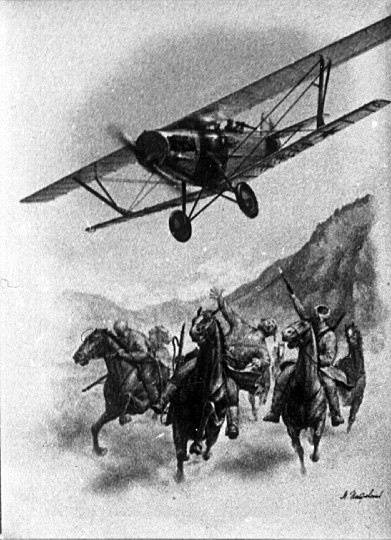
On the Southern Front in August 1920 on the Kakhovsky bridgehead, the red command was amazed at the speed of the transfer of enemy forces, especially transports. And the command set the task for its aviation: to find out what is in the thousands of peasant supply that make up the enemy's convoy. Repeated reconnaissance provided the same information: a convoy was moving, and behind it a 5-long convoy — 6 km — which indicated the absurdity of the number of the moving unit. Finally, with the help of aerial reconnaissance and comparison of its results with the testimony of prisoners, it was revealed that this is a large-scale misinformation.
The air reconnaissance in the Civil War had some features related to the lack of a solid front and other circumstances. Artillery groups were sparse, guns were located, as a rule, platoons, carts and reserves in most cases were absent. Often these factors explained that the air reconnaissance in the Civil War gave weak results.
In the First World War, aviation as a means of communication, especially on the Russian front, was used poorly. In the Civil War, however, aviation as a means of communication played a key role.
In the absence of proper telegraph, radiotelegraph, and other communications, air communication between groups of troops and headquarters at various levels was of continued importance. In many cases, it was the only link. The moral significance of such a connection for isolated parts was also very great. The ability to use outdated types of aircraft gave a wide opportunity to establish aviation communications.
Individual units often received tasks of a directive nature for a considerable period of time - and they had to act in fact on their own initiative. In this regard, the only means that could help the command to communicate with these units - is aviation.
Thus, in the spring of 1919, the red 9 Army, due to the onslaught of superior enemy forces and the uprising of the Greens in its rear, found itself in a quandary. The connection between the separate parts was broken, the Povorino-Balashov railway was cut. The only hope of contacting the division headquarters is in terms of aviation. The latter, separated from its base by more than 600 km, lacking fuel and lubricants, performed the assigned tasks in extremely difficult conditions. Simultaneously, the work of communication is accompanied by reconnaissance, bombing and agitation.
When, in 1919, the red Uralsk was besieged by white on all sides, aviation was also the only means of communication.
In May 1920, during the withdrawal of the Red Army from Rechitsa on the Western Front, it was necessary to establish a link between the army headquarters and the divisions, which, due to the rapid retreat, lost all contact. And again the problem was solved successfully.
Aviation was used to establish a connection between Soviet Russia and Khiva and Bukhara.
Active and white aircraft. Thus, in 1919, special flights were organized under the command of Colonel Veselovsky, which established a continuous connection between the rebels and the political and military center of the Don Cossacks, Novocherkassk, to maintain communication between the individual Cossack detachments operating at the front and in the rear of the Red Army. During the raid on the Mamontov Corps, the link between the Cossacks and the main forces of the VSYUR was maintained exclusively by aviation.
But in the Civil War, aviation communication was more episodic rather than permanent.
It was carried out by aviation and special assignments - for example, it scattered propaganda literature, carried out the delivery of agents, agitators to the rear of the enemy to perform certain tasks. Similar actions were carried out during World War II on the Eastern Front in 1916 — when enemy agents landed from airplanes in the rear of the Russian army.
The work of aviation in spreading campaign literature took place over settlements, combat positions, large reserves and troop concentrations. There are numerous cases in which, thanks to the proclamations spread by planes, entire enemy units switched over to the Reds (for example, from the Kolchak army on the Eastern Front).
Aviation in the Civil War was also an important means of dealing with all sorts of rebel and partisan detachments. So, the uprising in the cities. Syzran and Balashov were suppressed by the actions of aviation, which, attacking in groups, made a strong impression - dispersing the enemy with machine-gun fire. The same thing happened in Samara: two raids on the city produced a demoralizing effect.
Thus, during the struggle with the Makhno gangs, according to intelligence reports, under pressure from the red cavalry, the enemy retreated as part of two infantry and two cavalry regiments, 50-ti machine guns and 3-guns and went to the railway station, where the squadron was located and a small garrison by force up to two mouths. The squadron organized several hours later and, rising into the air, met the gang with a devastating bombing strike. By this, the pilots forced Makhno to go the other way — by saving the little red garrison from certain death.
During the 11 - 22 period of August 1921, in battles north of the Kirsanov railway, the main Antonov forces were dispersed by red aircraft. But by April X at the 10, Antonov had again gathered sabers before 5000 - with which he headed to the Novo-Nikolayevskoye area. On April 11, Antonov unexpectedly turns to Rasskazovo village and, having caught the garrison without warning, occupies the village. The brigade headquarters, surrounded by a gang, was shot in the environment. At the disposal of the command of the reserves was not - except for the squadron, which immediately and was called for help. The raid on the village of Rasskazovo led to the fact that the pilots with machine-gun fire and bombs saved the brigade headquarters.
In the Civil War, aviation was not only an auxiliary, but also a shock arm of the troops, making a huge moral impression on the enemy. But attempts of mass use of aircraft with decisive combat targets were rarely successful. The bulk of the combined-arms commanders could not properly manage the aviation resources, and the flights were mostly sporadic.
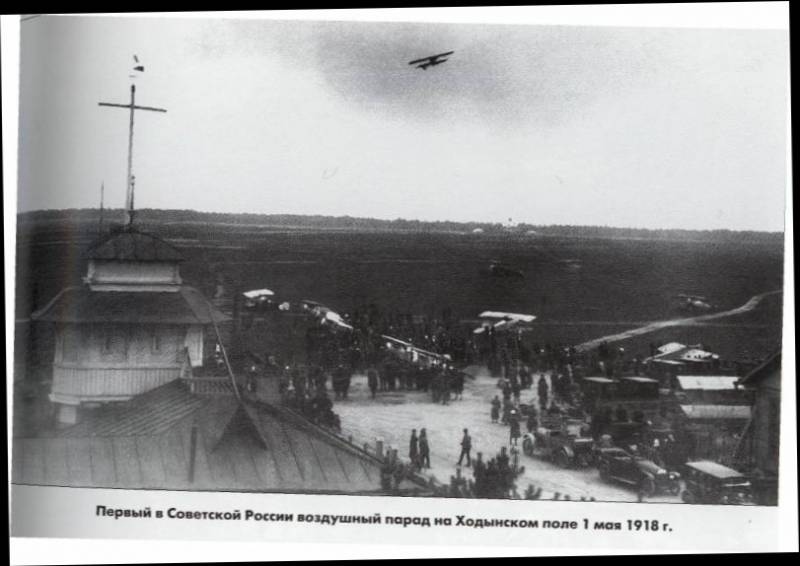
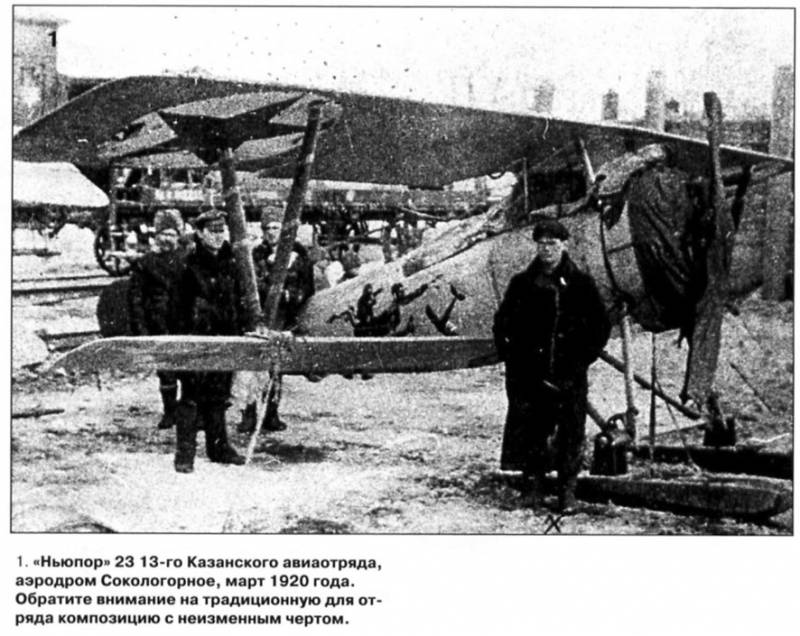
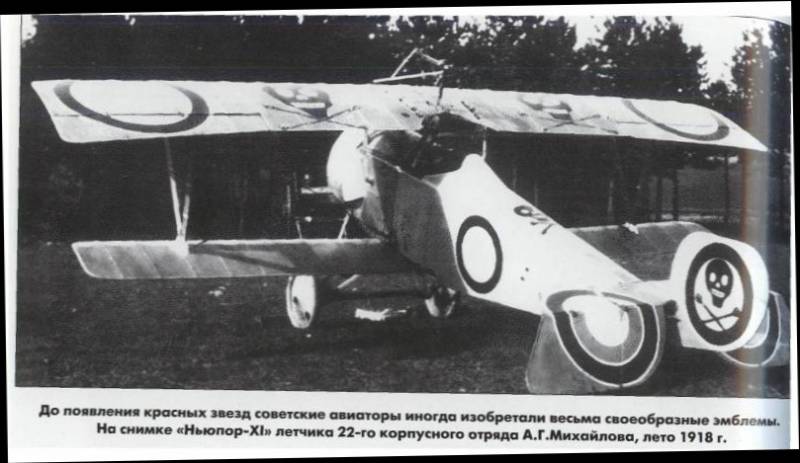
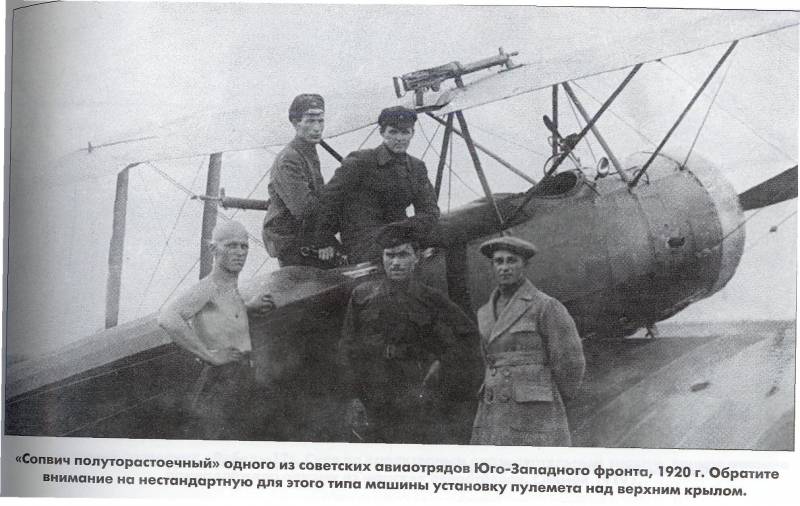
Information